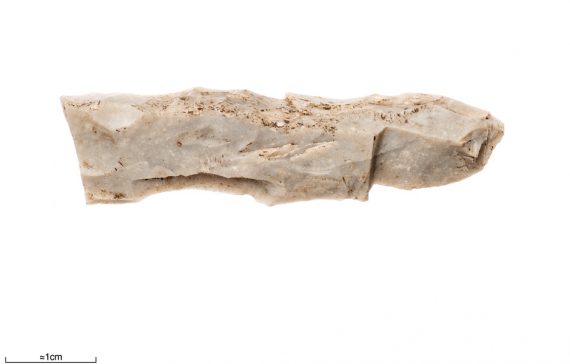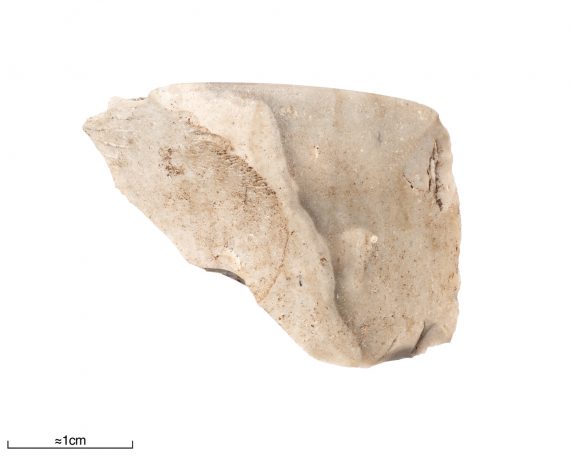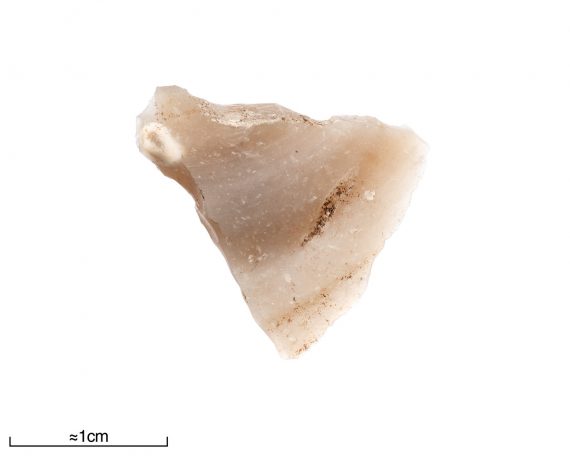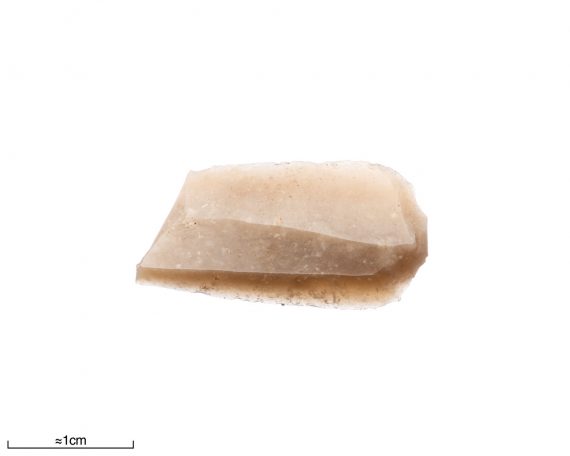Recording of the flint artefacts
Otto Frödin’s excavations
The terminology used in the registration of this flint assemblage differs from that used for the later excavations. The following table gives some translations of the terms used and some approximate synonyms.
| Swedish | English | Approximate synonym |
| A-spån | Blade | |
| Avfall | Waste | Debitage |
| Avslag | Flake | |
| Avslagskniv | Flake knife | |
| Bipolär kärna | Bipolar core | |
| Bipolärt avslag | Bipolar flake | |
| Borr | Drill | |
| B-spån | B-blade | |
| Cylindrisk spånkärna | Cylindrical blade core | |
| Debitage | Debitage | Avfall |
| Eldslagningsflinta | Strike-a-light | |
| Enkel spånskrapa | Single-edged blade scraper | |
| Fyrsidig yxa | Square-sectioned axe | Check also thin-butted axe, thick-butted axe, thin-bladed axe |
| Knacksten | Hammerstone | |
| Kniv | Knife | |
| Kort spånfragment | Short blade fragment | |
| Kärna | Core | |
| Plattformsavslag | Platform flake | |
| Rund skivskrapa | Round scraper | |
| Ryggspån | Backed blade | |
| Skivborr | Flake drill | |
| Skivskrapa | Flake scraper | |
| Skrapa | Scraper | |
| Skärvskrapa | Debitage scraper | |
| Splitter | Microflake | |
| Spån | Blade | |
| Spånborr | Blade drill | |
| Spånfragment | Blade fragment | |
| Spånkniv | Blade knife | |
| Spånpilspets med tånge | Tanged arrowhead | Tanged point |
| Spånskrapa | Blade scraper | |
| Tjocknackig yxa | Thick-butted axe | Check also square-sectioned axe |
| Tunnackig yxa | Thin-butted axe | Check also square-sectioned axe |
| Tunnbladig yxa | Thin-bladed axe | Check also square-sectioned axe |
| Tväreggad pilspets | Transverse arrowhead | Transverse point |
| Tångepilspets | Tanged arrowhead | Tanged point |
| Yxa | Axe | |
| ändskrapa | End scraper |
Fig. 1. Terminology used for registration of flint recovered from Otto Frödin’s excavations
The terminology used in the records registered by Hans Browall (object number 483520 to 875338) follows Malmer 1969.
Mats P. Malmer’s excavations
The registration of flint materials from Mats P. Malmer’s excavations of the Alvastra pile dwelling was done according to the definitions in the recording scheme Andersson et al (1978). Adjustments to the scheme were made by Gregory Strand Tanner in order to include the lithic material in the digital recording system used by the Swedish History Museum.
Definitions with adjustments can be found in the list of artefacts below. Registration had to be performed in Swedish, due to set parameters within the database system, though all terms were subsequently translated to English (see fig. 2).
| Material | Sakord svenska | Type English | Typ svenska | Sub-type English | Del svenska | Part English |
| Flinta (flint) | yxa | axe | fyrsidig yxa med slipad egg | square-sectioned axe with polished edge | egg | edge |
| nackfragment | axe butt | |||||
| fyrsidig yxa | square-sectioned axe | egg | edge | |||
| nackfragment | axe butt | |||||
| spets | point | typ a spånpilspets med tånge | tanged blade arrowhead, type A | |||
| tväreggad spets | transverse point | |||||
| borrspets | drill | |||||
| skrapa | scraper | dubbel-spånskrapa | double-edged blade scraper | |||
| enkel spånskrapa | single-edged blade scraper | |||||
| ändskrapa | end scraper | |||||
| rundskrapa | Round scraper | |||||
| skedformig skrapa | spoon-shaped scraper | |||||
| sidskrapa | side scraper | |||||
| spånskrapa | blade scraper | |||||
| kniv | knife | spånkniv | blade knife | |||
| stickel | burin | mittstickel | centre burin | |||
| kärna | core | bipolär kärna | bipolar core | |||
| övrig kärna med en plattform | other platform core w one platform | sidofragment | side fragment | |||
| plattformsavslag | platform flake | |||||
| övrig kärna med två plattformar | other platform core with two platforms | sidofragment | side fragment | |||
| plattformsavslag | platform flake | |||||
| spån | blade | kort spånfragment | short blade fragment | proximalfragment | proximal fragment | |
| medialfragment | medial fragment | |||||
| distalfragment | distal fragment | |||||
| spånfragment | blade fragment | proximalfragment | proximal fragment | |||
| medialfragment | medial fragment | |||||
| distalfragment | distal fragment | |||||
| ryggspån-fragment | crested blade fragment | proximalfragment | proximal fragment | |||
| medialfragment | medial fragment | |||||
| distalfragment | distal fragment | |||||
| mikrospån | microblade | proximalfragment | proximal fragment | |||
| medialfragment | medial fragment | |||||
| distalfragment | distal fragment | |||||
| avslag | flake | |||||
| splitter | microflake | |||||
| mikrosplitter | small micro- flake | |||||
| debitage | debitage |
Fig. 2. English translations
Method
Information regarding find context is recorded for every find but varies depending on the available context information. The information includes some combination of x/y-coordinates, level (z), find no., feature no., type of feature, year of excavation, trench, layer and other relevant context information.
An analogue basic recording of the flint artefacts was done after each season of excavation 1976-1980. The find numbers generated during that recording are passed on to the digital recording as a find number (fyndnummer). It should be noted that the recording scheme used during the recent digital recording (Andersson et al. 1978) is not the same scheme that was used during the earlier recordings. Therefore, an artefact recorded in connection with the excavations in the 1970s might have a new interpretation today.
Each find is recorded based on the type of artefact (sakord), sub-type (typ), part (del), material (material), number of finds (antal ex) and number of fragments (antal fragment). Though kept to a minimum, finds are sometimes further described in the description (beskrivning). Any other comments relating to the find can be found as a note (anmärkning).
Special consideration should be made to the sub-types of each type of artefact. Each sub-type has the possibility to have one of the following extensions:
| Swedish extensions | English translations |
| … med slipad yta | … with polished surface |
| … med retusch | … with retouch |
| … med retusch och slipad yta | … with retouch and polished surface |
For example, a bipolar core with polished surface would be listed as:
Type of artefact: core (kärna)
Sub-type: bipolar core with polished surface (bipolär kärna med slipad yta)
Some information regarding the flint finds is recorded as key words. One key word regards the material source (materialkälla) of the flint, which was determined by optical methods, based on flint descriptions by Högberg and Olausson (2007). The flint consists of; Senonian flint (senonflinta), Danian flint (danienflinta), Kristianstad flint (kristianstadflinta) or Ordovician flint (ordovicisk flinta). The presence of cortex (kritkrusta) and pieces displaying naturally rounded sides, which is commonly found on beach/river flints, were also recorded using the term rullstenskrusta.
Artefacts of flint
Axe (yxa)
Axes were sub-categorised into two types; square-sectioned axe (fyrsidig yxa) or square-sectioned axe with polished edge (fyrsidig yxa med slipad egg). When the part (del) of the axe could be distinguished, this was also recorded as edge (egg) or butt fragment (nackfragment).
Complete axes and axe fragments were distinguished from each other in the digital recording by using different fields in the database. The field number of finds (antal ex) was used for complete axes while the field number of fragments (antal fragment) was used for axe fragments.

Fig. 3. Object number 1186276. Square-sectioned axe. Photo: Ola Myrin, Swedish History Museum (SHM).

Fig. 4. Object number 118638. Polished edge of square-sectioned axe. Photo: Ola Myrin, Swedish History Museum (SHM).
Point (spets)

Fig. 5. Object number 1285179. Transverse point, flint. Photo: Ola Myrin, Swedish History Museum (SHM)
Points were sub-categorised into three types (typ); the transverse point (tväreggad spets), tanged blade arrowhead, type A (typ a spånpilspets med tånge) or blade drill/borer (borrspets).
Complete points and point fragments were distinguished from each other in the digital recording by using different fields in the museum database. The field number of finds (antal ex) was used for complete points while the field number of fragments (antal fragment) was used for point fragments.
Scraper (skrapa)

Fig. 6. Object number 1282187. Simple blade scraper, flint. Photo: Ola Myrin, Swedish History Museum (SHM).
Scrapers were sub-categorised into seven types (typ); blade scraper (spånskrapa), single-edged blade scraper (enkel spånskrapa), double-edged blade scraper (dubbelspånskrapa), round scraper (rundskrapa), end scraper (instead of simple flake scraper: ändskrapa), side scraper (a flake scraper with retouch along one or both long edges and end; sidskrapa) or spoon-shaped scraper (skedformig skrapa).

Fig. 7. Object number 1185226. Spoon-shaped scraper. Photo: Ola Myrin, Swedish History Museum (SHM).
Complete scrapers and scraper fragments were distinguished from each other in the digital recording by using different fields in the database. The field number of finds (antal ex) was used for complete scrapers while the field number of fragments (antal fragment) was used for scraper fragments.
Knife (kniv)
All recorded knives were placed in sub-type (typ); blade knife (spånkniv).
Complete knives and knife fragments were distinguished from each other in the digital recording by using different fields in the database. The field number of finds (antal ex) was used for complete knives while the field number of fragments (antal fragment) was used for knife fragments.
Burin (stickel)
All recorded burins were placed in sub-type (typ); centre burin (mittstickel).
Complete burins and burin fragments were distinguished from each other in the digital recording by using different fields in the database. The field number of finds (antal ex) was used for complete burins while the field number of fragments (antal fragment) was used for burin fragments.
Core (kärna)
Cores are defined as pieces of flint that are displaying negatives of knapped flakes or blades.
Cores were sub-categorised into three types (typ). Platform cores were categorised as other platform core with one platform (övrig kärna med en platform) or other platform core with two platforms (övrig platformskärna med två plattformar). Another type of core is the bipolar core (bipolar kärna).
When it was possible to distinguish the type of fragment it was recorded in the field part (del) as side fragment (sidofragment) or platform flake (plattformsavslag).
Complete cores and core fragments were also distinguished from each other in the digital recording by using different fields in the database. The field number of finds (antal ex) was used for complete cores while the field number of fragments (antal fragment) was used for core fragments.
Blade (spån)
Blades are defined as having a platform and percussion bulb. They must also have a 1:2 width to length ratio and be wider than 8 mm. They should also show signs of being knapped as a part of a serial production by having blade negatives on their dorsal sides. Blade negatives should be oriented in the same direction as the parallel edges of the blade. The blade thickness should not be larger than 2/3 of the blade width.
Blades were sub-categorised into three types (typ). The types relate to different form of fragmentation as blade fragment (spånfragment), short blade fragment (kort spånfragment) or crested blade fragment (ryggspånfragment).
The blade fragments are further recorded in the field part (del) as proximal fragment (proximalfragment), medial fragment (medialfragment) or distal fragment (distalfragment).
Complete blades and blade fragments were also distinguished from each other in the digital recording by using different fields in the database. The field number of finds (antal ex) was used for complete blades while the field number of fragments (antal fragment) was used for blade fragments.
Microblade (mikrospån)
Microblades share the characteristics of the blade but they have a smaller width than 8 mm at their widest point and must be longer than 10 mm at their longest point.
Microblades were not sub-categorised.
The microblade fragments are further recorded in the field part (del) as proximal fragment (proximalfragment), medial fragment (medialfragment) or distal fragment (distalfragment).
Complete microblades and microblade fragments were also distinguished from each other in the digital recording by using different fields in the database. The field number of finds (antal ex) was used for complete blades while the field number of fragments (antal fragment) was used for microblade fragments.
Flake (avslag)
Flakes are defined as a knapped fragment which contain a platform and a percussion bulb. The flake must be larger than 10 mm at its widest point.
Flakes were not sub-categorised. All flakes (fragments and complete flakes) were recorded in the field number of finds (antal ex). There is no separation between complete and fragmented flakes, in accordance with the applied recording scheme (Andersson et al. 1978).
Microflake (splitter)
Microflakes were defined as all flints smaller than 10 mm but larger than 3 mm at their largest point.
Microflakes were not sub-categorised. All microflakes were recorded in the field number of finds (antal ex).
Small microflake (mikrosplitter)
Small microflakes were defined as all flints smaller than 3 mm at its largest point.
Microflakes were not sub-categorised. All microflakes were recorded in the field number of finds (antal ex).
Debitage
Debitage is term commonly used to describe the lithic “waste” created during the process of tool production. The term is used in a variety of ways, referring to different combination of blades, flakes, cores, micro flakes etc. Here, debitage is defined as the knapped flint fragments that were not able to be recorded as one of the other categories. In the registration scheme (Andersson et al 1978) the term other flint is used. Debitage replaces this term.
All debitage was recorded in the field number of finds (antal ex). It is gramatically difficult to talk of numbers of debitage as debitage is a collective noun. Despite this, numbers are used in the database.
Text; Gregory Hayden Strand Tanner, Sandra Söderlind
The following references cited on this page have no web links:
Andersson, S., Rex-Svensson, K., Wigforss, J., 1978. Sorteringsschema för flinta. Fyndrapporter, 1978:217-252. Göteborg.
Högberg, A., Olausson, D., 2007. Flint-An archaeological perspective. Aarhus University Press.
Malmer, M.P., 1969. Gropkeramiksboplatsen Jonstorp RÄ. Antikvariskt arkiv 36. Kungl. Vitterhets Historie och Antikvitets Akademien. Stockholm.